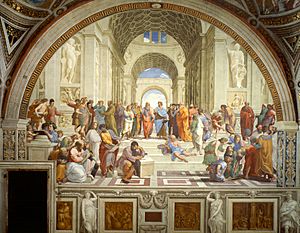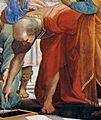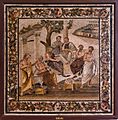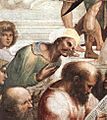The School of Athens facts for kids
The School of Athens is a very famous fresco painting by the Italian artist Raphael. He painted it during the exciting time known as the Italian Renaissance, between the years 1510 and 1511. Many people consider this painting to be Raphael's greatest work. It perfectly shows the ideas and spirit of the High Renaissance period.
Raphael was asked to decorate several rooms in the Apostolic Palace in Vatican City. These rooms are now called the Stanze di Raffaello. The School of Athens is one of the amazing frescoes he created for these rooms.
Who Are the People in the Painting?
It's not always clear who all the people in The School of Athens are. However, we know for sure that some of the most famous thinkers, like Plato and Aristotle, are there.
Here is a list of some of the people who might be in the painting:
- 1: Zeno of Citium
- 2: Epicurus (or maybe Heraclitus and Democritus)
- 3: Unknown (some think it's Raphael himself!)
- 4: Boethius, Anaximander, or Empedocles
- 5: Averroes
- 6: Pythagoras
- 7: Alcibiades or Alexander the Great
- 8: Antisthenes, Xenophon, or Timon
- 9: Raphael, Fornarina (as love), or Francesco Maria della Rovere
- 10: Aeschines or Xenophon
- 11: Parmenides (who looks like Leonardo da Vinci)
- 12: Socrates
- 13: Heraclitus (who looks like Michelangelo)
- 14: Plato (who also looks like Leonardo da Vinci)
- 15: Aristotle (who looks like Giuliano da Sangallo)
- 16: Diogenes of Sinope
- 17: Plotinus (who might look like Donatello)
- 18: Euclid or Archimedes with students (who might look like Bramante)
- 19: Strabo or Zoroaster (who looks like Baldassare Castiglione)
- 20: Ptolemy
- R: Apelles (who looks like Raphael)
- 21: Protogenes (who might look like Il Sodoma, Perugino, or Timoteo Viti)
More Pictures of the Painting
-
A mosaic from Pompeii showing Plato's Academy.
-
Pythagoras and Archimedes.
-
Archimedes showing his principle.
-
Aeschines and Socrates.
-
Alcibiades or Alexander the Great and Antisthenes or Xenophon.
-
Possibly Zeno of Citium.
-
Averroes and Pythagoras.
-
Possibly Epicurus or Democritus.
See also
 In Spanish: La escuela de Atenas para niños
In Spanish: La escuela de Atenas para niños





















